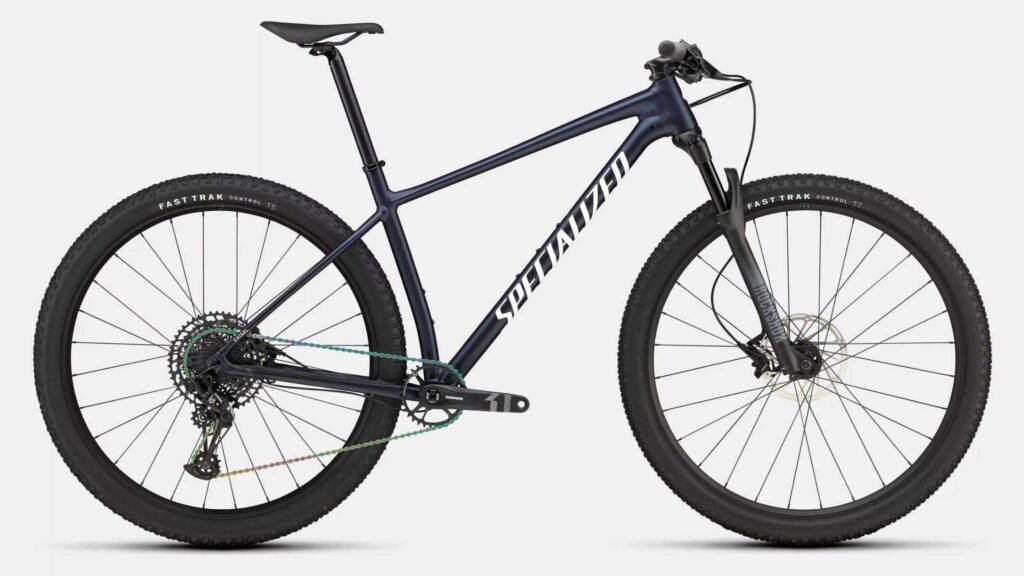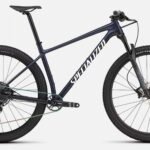If you’ve been mountain biking for a while, or maybe you’re planning to finally upgrade your ride, you have probably hit that same confusion many of us did — Should you go for a Chisel Hardtail or a Full Suspension?
Honestly, it’s not as simple as “this one’s better”. It depends on how you ride, where you ride, and what you want from your bike.
For simplicity, you can fit a Chisel Hardtail, which is cheaper too, but if you want advanced riding, you can with a Full Suspension.
So let’s break it down like I always do — simple, real talk, every angle that matters.
What Exactly Is a Chisel Hardtail?
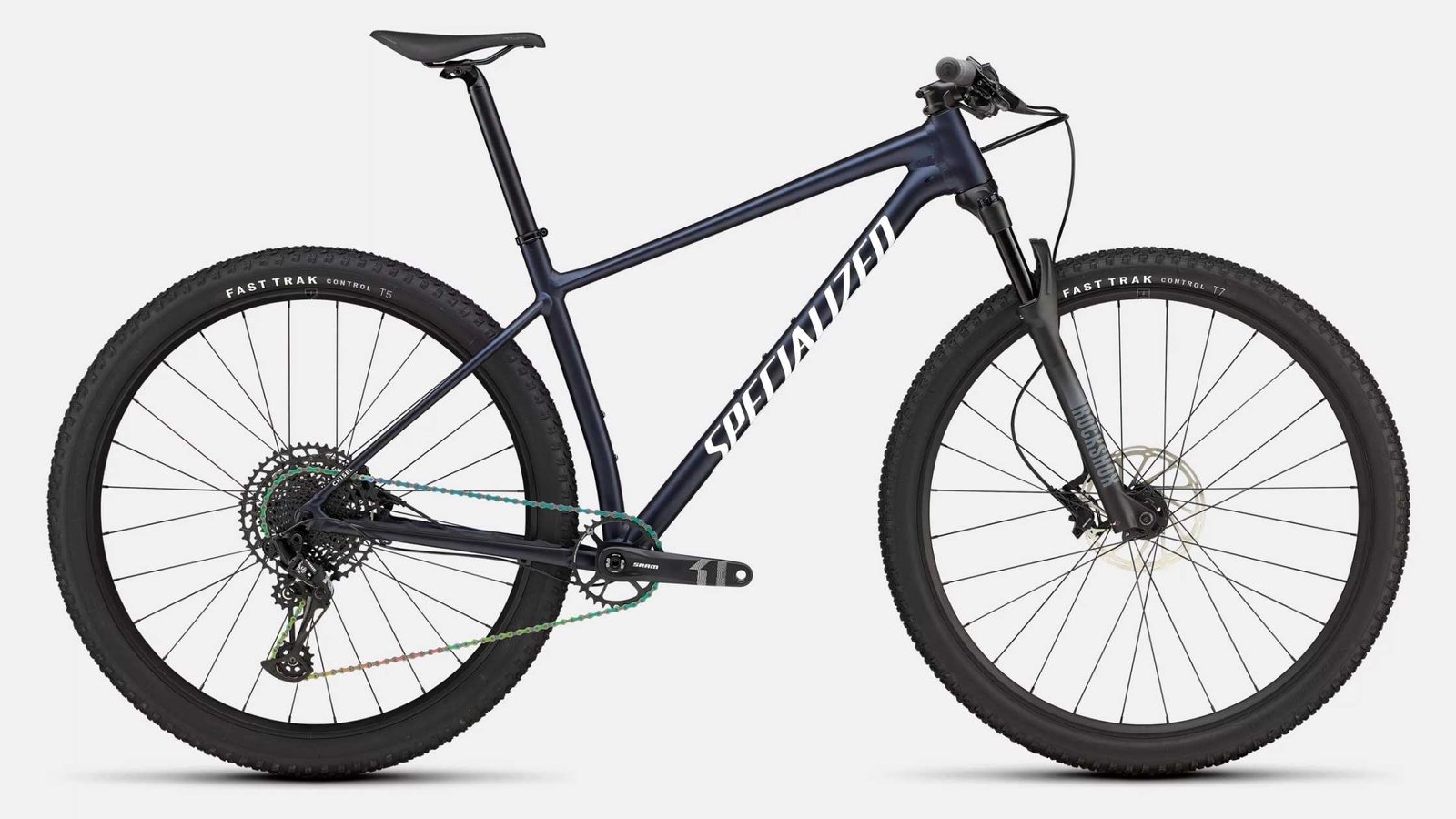
Image credit: Specialized Bicycles – specialized.com
First, let’s clear this up. The Specialized Chisel is basically one of the most popular XC (Cross Country) hardtails in the market.
It’s lightweight, responsive, and built for pure efficiency.
A hardtail, in simple words, means you only get front suspension, and the rear stays rigid.
So you’ve got a suspension fork upfront to absorb hits, but your back wheel connects straight to the frame.
Now, why does this matter? Because that stiffness changes how you ride. It transfers power better, feels snappy, and climbs like a beast.
If your trails are smooth-ish, with rolling climbs and descents, and you care about speed, efficiency, and weight, a Chisel Hardtail will probably feel perfect.
Also read: What Happens If You Bike Every Day for 30 Minutes? — see how small daily rides impact endurance and comfort over time.
What Is a Full Suspension Bike?

Now, on the flip side, a Full Suspension bike gives you both front and rear suspension.
That means it absorbs a lot more impact. Rough trails, rocky descents, drops — the bike handles it smoother, and your body doesn’t take all the beating.
However, it also adds weight, complexity, and cost. You have got shock linkages, pivots, and extra maintenance.
A full-suspension bike shines when you ride aggressive trails, technical downhill, or long backcountry stuff where traction and control matter more than raw pedaling efficiency.
If you’ve read my guide on 9 Effective Ways to Build Stamina for Longer Mountain Bike Rides, you already know — fatigue control matters.
And full-suspension bikes help massively in that regard, especially on longer rides.
Ride Feel — Direct vs Smooth
This is probably where you’ll feel the biggest difference between these two.
A Hardtail (like the Chisel) feels direct, you feel the trail, every root, every stone — you’re part of it. It’s raw, but that’s what a lot of riders love.
It gives you skill feedback; it actually makes you a better rider because you learn to choose lines properly.
Meanwhile, Full Suspension just smooths everything out. It feels plush, forgiving; even if you hit the wrong line, you’ll survive it.
But it also disconnects you a bit from the trail. It’s more forgiving, but less “pure”, if you get what I mean.
And when you’re doing XC races or local loops, that crisp power from a Chisel Hardtail? It’s hard to beat.
Weight and Speed — The Efficiency Factor
The Chisel Hardtail usually wins hands down here. Less frame material, no rear shock system — it’s lighter.
We’re talking 1–2 kg lighter than many comparable full-suspension setups.
And that means more speed uphill and more energy saved over time.
If your goal is to climb faster, or you’re doing XC and marathon-style rides, the hardtail’s efficiency feels unbeatable.
But if your trail is rough, technical, and you spend more energy trying to stay upright, that “efficiency” disappears fast.
Because the bumps slow you down, even if your bike’s lighter.
Full Suspension gives better traction, meaning you keep more consistent power on rough terrain. Sometimes that’s actually faster overall.
Maintenance and Durability
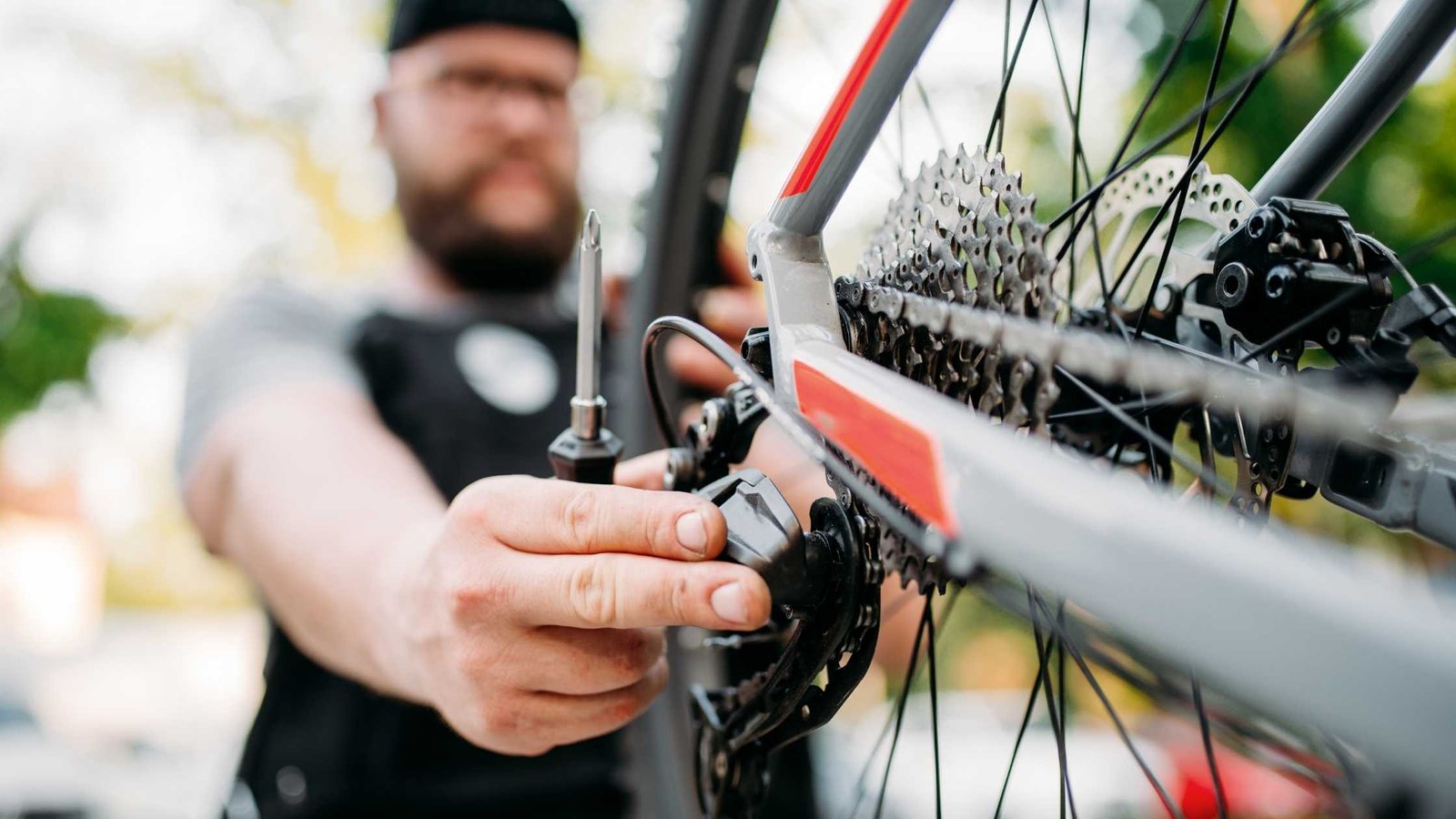
Here’s the real-world side of it — maintenance.
Hardtails are simple. You’ve got fewer moving parts, fewer bearings, and no rear shock to tune.
Clean it, lube it, ride it. That’s it.
Full Suspensions, though — they need care. Shock service, linkage bearings, regular inspections.
It’s not complicated, but it’s more stuff to stay on top of.
Also read: Starting Mountain Biking at 40 — 10 Tips to Follow — even if you’re starting later, a simpler setup like a hardtail can help build better trail confidence early on.
Comfort and Fatigue Over Time
Now this one — it’s where most people underestimate Full Suspension.
If you do long rides or technical descents, that constant vibration from a hardtail does build up fatigue.
Your lower back, arms, and knees feel it after 2–3 hours.
Full Suspension bikes absorb a lot of that. The rear shock takes care of chatter, so your body can ride longer with less strain.
That’s why even though a hardtail can feel “faster” on paper, on real rough terrain, a full suspension keeps you fresher longer.
Price Difference — The Big Decider
This part can’t be ignored.
Hardtails like the Specialized Chisel come in much cheaper. For the same money, you’ll get higher-end components on a hardtail compared to what you’d get on a full-suspension frame.
A Chisel Hardtail typically starts around $1,200–$1,800, depending on the specifications.
The mid-level builds usually sit between $2,000 and $3,500, and the high-end, race-focused versions easily climb to $4,000–$6,000+.
Now, compare that to a Full Suspension with the same drivetrain and brakes — you’re instantly adding around $1,000–$2,000 more.
So expect good full-suspension bikes to start roughly around $1,800–$2,500, solid mid-range builds to fall between $3,000–$5,000, and high-end models easily pushing $6,000–$9,000+, depending on brand and frame tech.
If your budget is tight, a Chisel is a smart move. It’s race-ready, reliable, and easy to upgrade later.
But if you’re willing to invest more, a full suspension will give more comfort, traction, and versatility overall.
It really depends on whether you value simplicity + speed or comfort + control.
Where You Ride Matters More Than You Think
Where you live and how you ride decide almost everything here.
If your trails are smooth, XC-style, and you love sprinting and climbing — go Chisel Hardtail.
But if your area has rocky descents, roots, or you like hitting drops and technical downhill, Full Suspension is your friend.
I’ve seen many riders regret picking full suspension when their trails are mostly mild — the suspension just sits unused, and you carry the extra weight for nothing.
Likewise, some guys buy a Chisel, then realize they’re beating their spine every weekend on rough trails.
Also read: Clipless vs Flat Pedals — Which One Should You Really Choose? — because your pedal choice actually changes how both these bikes feel on climbs and descents.
Performance in Real Trail Scenarios
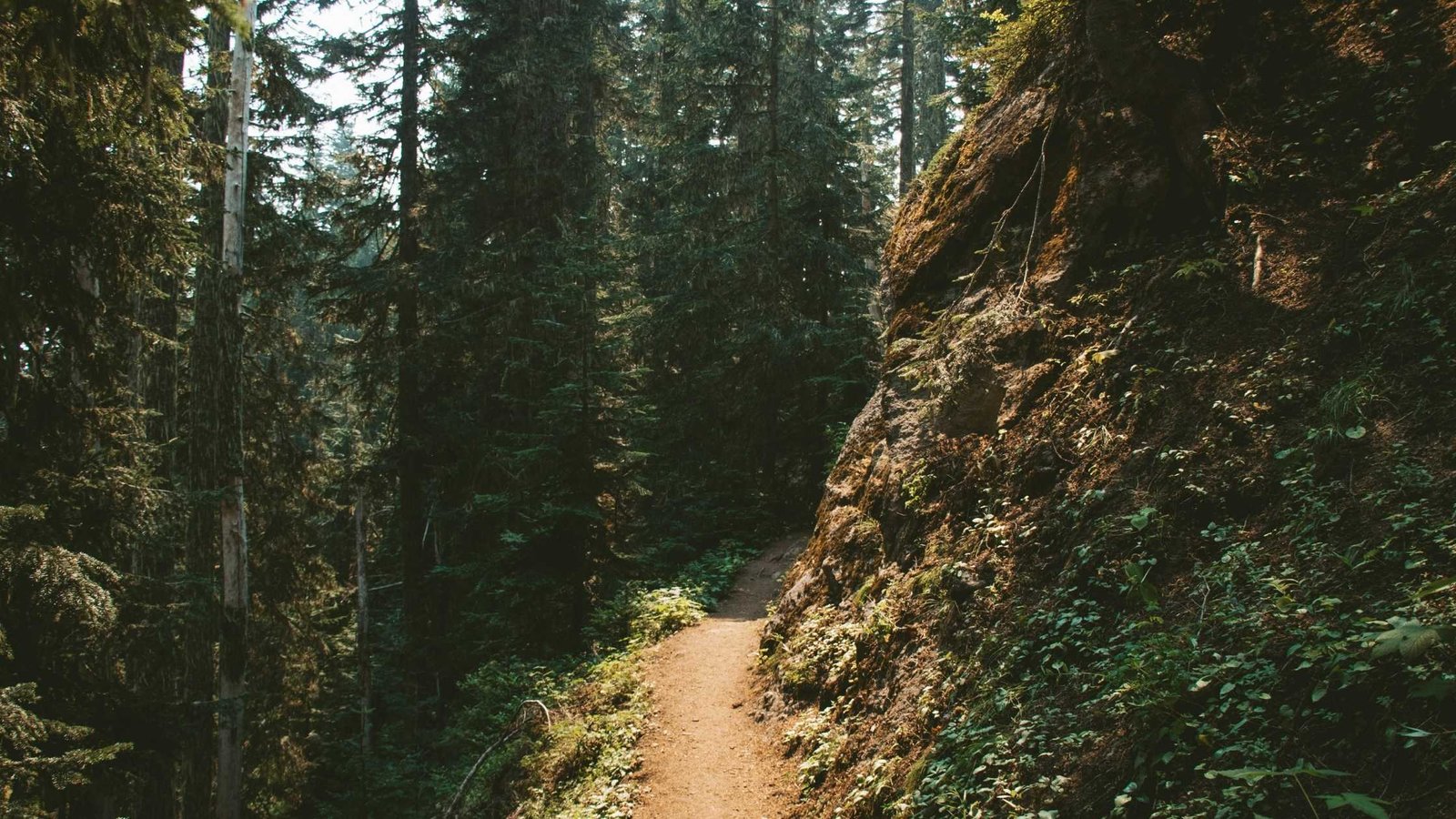
Now put them head-to-head in real trail conditions — because that’s what actually matters when you’re out there riding.
On Smooth XC Trails
- Chisel Hardtail: It is fast, super-efficient, and responsive. You will feel every pedal count.
- Full Suspension: Still good, but heavier and not as snappy on flat or flowy terrain.
On Rocky Descents
- Chisel Hardtail: Rougher ride, needs more skill and line choice. You’ll feel the hits.
- Full Suspension: Smooths everything out, better traction, easier to control at speed.
On Long Climbs
- Chisel Hardtail: It allows you to transfer power effectively, with no pedal bob, and climbs like a rocket.
- Full Suspension: Slightly pedal bob and extra weight make it slow a bit.
On Downhill or Enduro Trails
- Chisel Hardtail: It’s not really comfortable; you’ll need solid technique to stay smooth.
- Full Suspension: It has excellent control and stability, so you won’t feel rocks and drops.
For Maintenance
- Chisel Hardtail: It is very easy to clean, as it has fewer moving parts, and just basic care.
- Full Suspension: Needs more attention — bearings, pivots, shock service.
For Budget and Value
- Chisel Hardtail: Way cheaper for similar component quality.
- Full Suspension: Always costlier due to added suspension hardware and engineering.
Quick tip:
If your rides are about 50/50 XC and light trails, go Chisel Hardtail — it’ll serve you perfectly and keep things simple.
But if your rides are 70% or more rough terrain, technical descents, or downhill-focused, the Full Suspension clearly wins it.
Handling and Skill Building

This is something I personally love to talk about — skill progression.
A hardtail actually forces you to become smoother, smarter, and more precise.
Every mistake you make, the bike tells you instantly.
So if you’re still improving or want to refine your handling skills, the Chisel will help more than a full-suspension bike ever can.
But when you’re already advanced and want to push limits — jumps, rocks, faster corners — Full Suspension gives you that extra margin of safety and control.
Also read: What Is the Best Age to Start Mountain Biking? — because it’s never about age, it’s about learning pace and how you progress your control and technique.
Who Should Choose the Chisel Hardtail
You should go with the Chisel Hardtail if:
- You love climbing, racing, and efficiency
- You mostly ride XC or light trails
- You want less maintenance and lower cost
- You enjoy a direct, responsive feel
- You want to improve your bike handling skills
It’s light, simple, and rewarding, especially if you enjoy speed and connection with the trail.
Who Should Go for Full Suspension
You should go Full Suspension if:
- You ride rocky, rooty, rough trails often
- You prioritize comfort and control
- You plan longer rides or endurance days
- You’re into downhill or trail fun more than pure speed
- You don’t mind a bit of extra maintenance and cost
It’s perfect for riders who just want smoother, more confident rides without worrying about every bump.
Final Thoughts Before Choosing
If I had to sum it up — The Chisel Hardtail is all about speed, simplicity, and skill.
The Full Suspension is about comfort, control, and forgiveness.
Neither is wrong. But picking the one that matches your trails and riding style will make all the difference.
Sometimes I even tell people — start with a Chisel, learn the trails, grow your handling, and when you start pushing bigger terrain, then go full suspension.
That’s exactly how many good riders built their foundation.
And that’s what makes mountain biking fun — finding the right setup that matches you, not just the price tag or the brand hype.
FAQs — Chisel Hardtail vs Full Suspension
Here are some questions and answers.
Is a Chisel Hardtail actually faster than a Full Suspension?
Yeah, it is — but only where the trail lets it be. On smoother XC stuff or those long climbs, the Chisel Hardtail just feels alive.
Every bit of energy you push goes straight into speed. You will instantly feel how quickly it reacts when you stand and hammer.
But when things get rough, that speed fades fast. The Full Suspension might weigh a bit more, but it holds traction and keeps you planted.
You’re not wasting power bouncing around or fighting the trail. So on rougher terrain, sometimes the heavier bike ends up faster overall.
It’s simple — smooth trail, go Chisel. Chunky trail, go Full Suspension. That’s it.
Can a Hardtail take rough trails like a Full Suspension?
You can ride rough stuff on a hardtail — but it’s gonna test you.
The Chisel can handle roots, small rocks, drops, all good, but you’ll feel every hit. It keeps you sharp, though.
Forces you to ride smart, pick lines, and move your body right.
A Full Suspension just makes it easier. You can ride longer, faster, and not feel like your arms are cooked halfway down.
That rear shock saves your back more than you’d think. Not gonna lie, once you ride full-suspension on rough trails, it’s hard to go back.
So yeah, a Chisel can handle it — but it’ll also humble you a bit.
Which one’s better for beginners — Chisel Hardtail or Full Suspension?
If you’re just getting into mountain biking, go with the Chisel Hardtail first. 100%.
Here’s why — it teaches you real control. You’ll actually learn how to move with the bike, not just sit and bounce.
You’ll feel what good line choice means, how your body weight changes traction, and you’ll get strong handling habits fast.
A Full Suspension is fun and forgiving, but it hides a lot of mistakes. You won’t realize what you’re doing wrong till you switch back.
That’s why so many good riders start on hardtails — it builds the base.
Once you’ve got that feel, then yeah, move to full suspension if your trails demand it.
You will know exactly what you’re upgrading for — not just following hype.

Ali is the founder of Mountain Bike Insider and an passionate rider with years of hands-on experience in mountain biking. From testing gear to exploring trails, Ali writes based on real riding knowledge to help others make smart, safe, and enjoyable biking choices. Every guide is built on research, personal use, and a passion for the sport.

